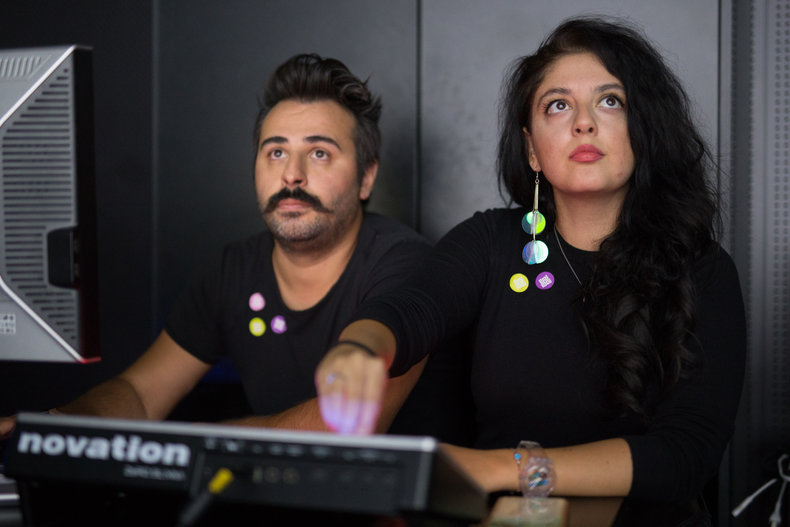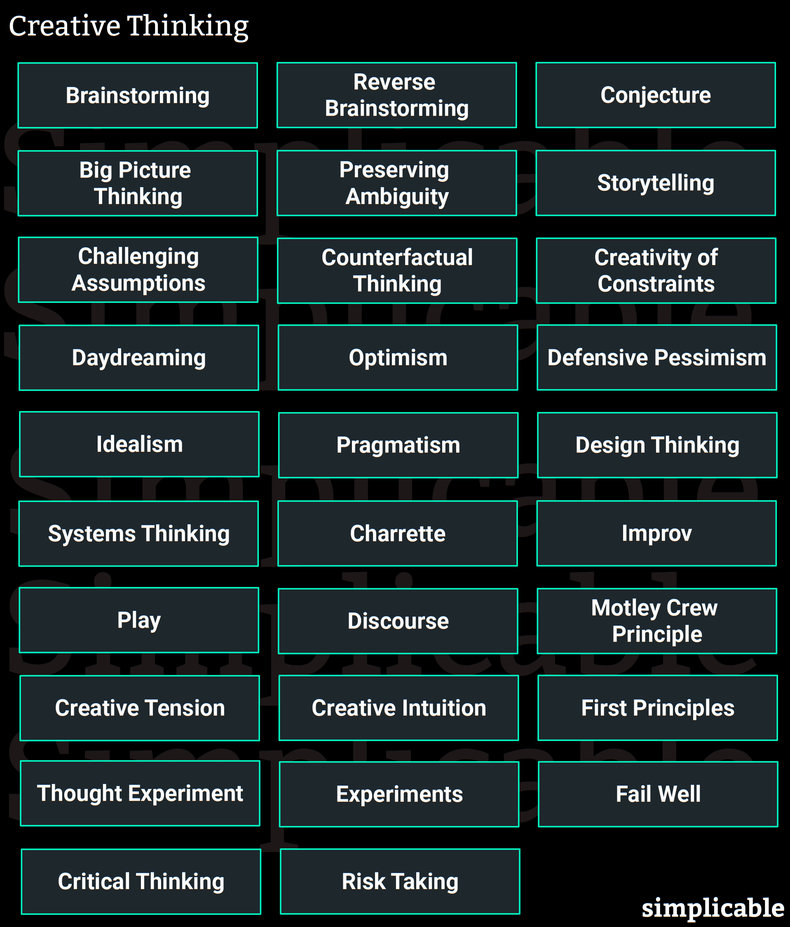

29 Examples of Creative Thinking  BrainstormingThe process of spitting out ideas without much thought. Prevents the common tendency for people to hold back their bravest ideas for fear of criticism.Reverse BrainstormingReverse brainstorming is same process as brainstorming but in response to a negative question such as "how can this plan fail?"ConjectureThe basic process of making educated guesses where information is missing. For example, a coach that predicts what the opposing team may do next in order to compose a creative response.Big Picture ThinkingThe practice of forgetting about details to look at overall strategy. For example, a marketing team that is always focused on optimizing monthly revenue that looks at their overall customer experience to find why the competition is outperforming.Preserving AmbiguityPreserving ambiguity is the principle that you delay any assumptions as long as possible because they tend to prevent creativity. For example, a shoe designer who explores designs without starting with a target market such that the shoe may end up being anything.StorytellingWrapping your proposals in storytelling as opposed to bland specifications. For example, design proposals for a clock that need to be wrapped in a fictional story of how the design changed someone's life.Challenging AssumptionsThe process of identifying the things that everyone has assumed and challenging these things. For example, an urban planner who challenges the assumption that roads are for cars.Counterfactual ThinkingCounterfactual thinking is the process of imaging how things could have been different in the past. For example, a train company that imagines how trains might have developed if aircraft had never been invented.Creativity of ConstraintsCreativity of constraints is the idea that constraints can force you to be more creative. For example, a team designing a bicycle helmet that is given the constraints that it must be safer than all other models on the market and cost less than $14 to produce.DaydreamingAllowing your imagination to work in an unrestricted way.OptimismOptimism is the practice of focusing on the positive potential in everyone and everything. This is a critical mode of thinking for creative processes.Defensive PessimismDefensive pessimism is the practice of validating your bravest ideas with negative criticism. This is often used to prune ideas that originate with optimistic processes such as brainstorming.IdealismIdealism is the theory that the world is a product of the mind and not the other way around. This may or may not be true but is a useful perspective for invention.PragmatismPragmatism is the process of being flexible to recognize the real complexities of a problem. This is another approach for making brave and optimistic ideas actionable. For example, an urban designer who produces a play street that is also usable by cars at low speed.Design ThinkingDesign thinking is the process of applying design to any domain, problem or decision. For example, a carpenter who designs a work process to increase their productivity.Systems ThinkingSystems thinking is the process of considering the end-to-end impact of change to complex systems. For example, a government that is considering taxing plastic to reduce pollution that attempts to identify potential unintended consequences of this policy in order to mitigate them.CharretteA charrette is an intense period of teamwork in the same space. For example, working on a problem for several days straight in the same room with long hours each day.ImprovImprov is a type of activity that is commonly used to break people out of static patterns of behavior for the purposes of creativity. This involves building upon a story together in a positive way according to a set of norms that don't allow you to reject ideas but only to build upon them.PlayPlay is the pursuit of joy. This may put people in the right frame of mind for imaginative thinking.DiscourseA process of communication can aid creativity. However, creativity is the output of an individual mind and groups are notorious for producing compromised solutions that are fully non-creative. As such, clear creative direction and creative control is required.Motley Crew PrincipleThe motley crew principle is the theory that intellectual diversity produces creativity and by contrast that groups that think alike are blind to original ideas. For example, an engineer + marketing person + customer service representative may come up with a more creative product design than 3 engineers or 3 marketing people.Creative TensionCreative tension is the theory that group disharmony produces creativity. For example, a team that intensely disagrees about a solution to a problem may be likely to find a more creative solution than a team that prioritizes feelings, agreement and saving face.Creative IntuitionIntuition is the ability of individuals to just know things without a process of conscious thought. For example, a fashion designer who knows a potent fashion trend when they see it.First PrinciplesFirst principles are foundational knowledge that have broad implications for a domain. For example, an environmentalist who adopts the principles of waste is food to design sustainable farming practices.Thought ExperimentA thought experiment is an analogy that is used to simplify a problem.ExperimentsThe process of trying things to see what happens.Fail WellThe design of experiments to fail quickly, cheaply and safely. For example, opening a food truck with a small investment before you go big to invest in a restaurant location.Critical ThinkingCritical thinking is disciplined or systematic thinking. For example, a farmer who systematically reviews data collected from a crop experiment.Risk TakingReserved, cowardly and mediocre thinking make creativity impossible. In order to be creative you take intellectual risks such as proposing ideas that are easy to criticise.CreativityThis is the complete list of articles we have written about creativity.If you enjoyed this page, please consider bookmarking Simplicable.
CreativityExamples of the creative process.
Improv
An overview of the rules of improv.
Originality
The definition of originality with examples.
Creative AbilityA list of creative abilities.
Abstract Art Characteristics
The defining characteristics of abstract art.
Ways Of ThinkingA list of thinking approaches and mindsets.Creativity Skills
A list of common creativity skills.
Creative Strengths
A list of common creative strengths.
Art Opposite
A list of things that can be considered the opposite of art.
Problem SolvingAn overview of problem solving with examples.
Problem Solving SkillsA list of common problem solving skills.Abstraction in Problem SolvingViewing a problem in general rather than specific terms.Confirmation Bias
The definition of confirmation bias with examples.
Good Failure
An overview of good failure with specific examples.
Socrates Philosophy
A summary of the philosophy of Socrates.
Four Causes
An overview of the four causes of Aristotle with five examples of each cause.
Practical Thinking
The definition of practical thinking with examples.
TrendingThe most popular articles on Simplicable in the past day.New ArticlesRecent posts or updates on Simplicable.
Behavior
Branding Business Business Analysis Business Disadvantages Business Models Business Strategy Cities Color Theory Colors Communication Computing Creativity Culture Customer Experience Customer Service Data Decision Making Design Design Thinking Economics Education Engineering Governance More ...
© 2010-2023 Simplicable. All Rights Reserved. Reproduction of materials found on this site, in any form, without explicit permission is prohibited. View credits & copyrights or citation information for this page. |